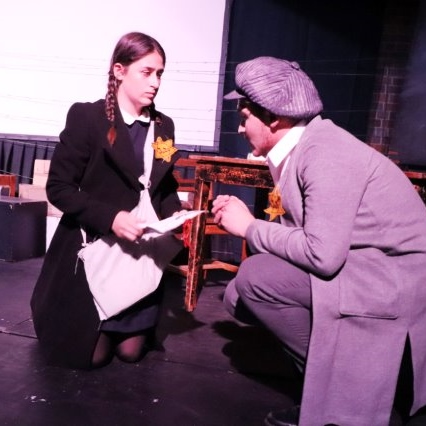click to dowload our latest edition
CLICK HERE TO SUBSCRIBE TO OUR NEWSLETTER


Published
6 years agoon
By
adminJORDAN MOSHE
Standing in front of this awestruck crowd, the two were questioned by the infamous angel of death, Dr Josef Mengele, and their lives changed forever.
“They brought us into a room. There we met Dr Mengele. He measured our heads, our arms, our wrists, and asked us some questions. Then he took Martha away into another room. That was the last time I saw my sister. I survived, but Martha didn’t.”
Telling the stories of those who suffered at the hands of the Nazis is no easy feat. Conveying their brutality and the terror of their victims is extremely difficult. Challenging though it may be, however, the need to remember their experiences is perhaps greater than ever. It makes it necessary to create different mediums through which to express the extent of their horror.
In a heartrending performance of their own creation, drama students of King David Victory Park (KDVP) captured the raw terror of Nazi Germany’s victims, drawing their audience into an experience unlike any other.
After their initial shock, guests were ushered into the seminar room to take their seats for the rest of the evening’s programme. They were shown a short film titled The Necklace. Conceived and directed by KDVP student Matthew Kimmelman, the monochromatic film told the story of a father and son imprisoned in a concentration camp. Nominated for the St David School’s Film Festival in 14 categories, the film won a prize for the best set, lighting, and costumes.
“This evening we’ve moved from our ordinary lives into the Holocaust, complete with its trauma, screams and sirens,” amateur historian, tour guide, and lawyer, Hugh Raichlin, told the audience. Raichlin has visited Poland on several occasions, and is familiar with the atrocities committed on its soil.
Raichlin stressed that events such as these highlight the need for us to understand the personal perspective of Holocaust victims, and shatter the common belief that they were led like sheep to the slaughter.
“If we leave here tonight with the understanding that no sane person could possibly brand these souls as passive, willing lambs led to their deaths, then we will have gained something profoundly special,” he said. “We need to focus on the resistance many of them achieved. These people not only resisted physically, but intellectually and spiritually as well, maintaining libraries, conducting classes, and even holding secret dramatic performances.
“Yes, we recognise those who rose up and challenged the German forces. But we need to look at all those souls, those who strove to preserve human dignity and assist others. These were not lambs, but lions.”
Raichlin’s talk was followed by the staging of I Never Saw Another Butterfly. Like the performance at the start of the evening, this was also produced and played by KDVP drama students, who delivered a truly remarkable performance.
Set in the ghetto of Terezin in the 1940s, the one-act play by American playwright Celeste Raspanti tells the story of Raja, one of the children who survived the ghetto. The play takes its name from a collection of works of art and poetry by Jewish children who lived in the concentration camp of Theresienstadt. This collection in turn takes the title from a poem by Pavel Friedmann, a young man born in 1921 who was incarcerated at Theresienstadt, and was later killed at Auschwitz.
The play deals with the lives of Raja and other children under the care of Irena Synkova, a committed teacher who tries to restore some semblance of normality by encouraging her students to sing, paint, and write.
Raja was 12 when she entered the camp. She watched her family and friends get deported until nearly everyone she knew and loved had died in the camps. Her parents. Her brother. Her aunt and friends. Even the first boy she ever loved.
“My family is gone, and I am alone,” she says. “But that is not important. What matters is that I am a Jew, and that I survived. I was one of the children of Theresienstadt. We got used to the slaps, the blows, and the executions. Goodbye was the motto of Terezin. The only thing that wouldn’t change.”
During the course of the play, Raja learns to live day by day with the suffering of the camp. She learns to part with those she loves, and strives to endure a life of poverty and abuse. When her beloved teacher is sent to the extermination camp, she continues to teach the children who remain.
She intones, “One must keep alive to teach the children how to sing and draw pretty pictures. The singing, the drawing, the painting. This was all part of our survival.”
Much like the opening of the evening, the audience was drawn into the terror and suspense of the play. When Raja concealed herself to avoid detection, actors in the guise of SS guards stalked across the room with torches, passing through an audience holding its breaths with every stride they took. Every person present was held enthralled throughout the performance, and many were visibly moved by what they witnessed.
At the end of the play, and the conclusion of Raja’s narrative, audience members rose to give the students a well-earned standing ovation.
It’s no easy task to tell the stories of those who lived through the atrocities of Europe in the grip of Nazism. The passion and sincerity with which these students communicated their experiences ensures that those who perished will remain ingrained in our minds for years to come.
